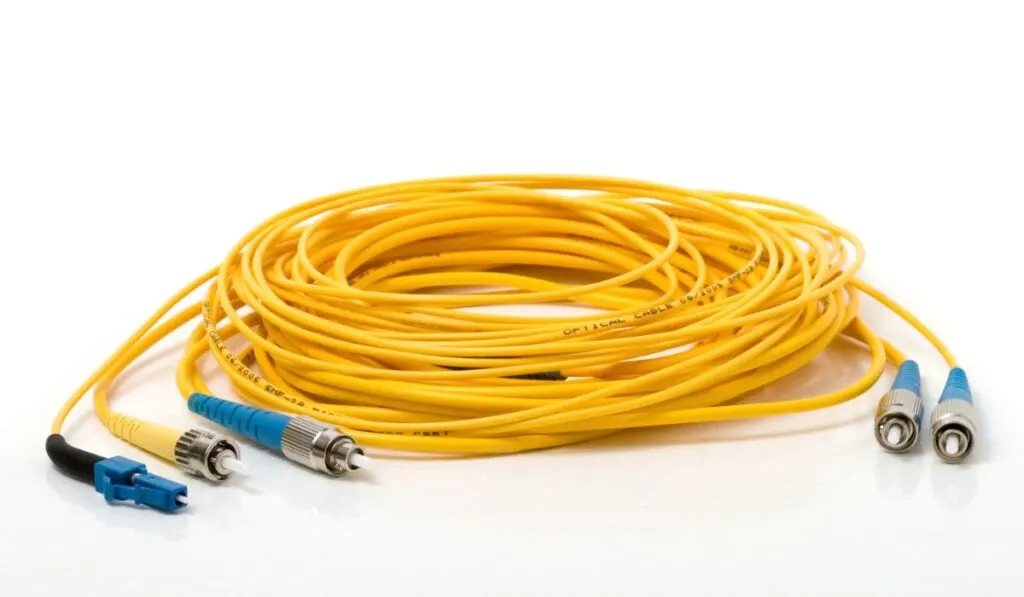The use of fiber optic cables for networking is increasingly becoming common since fiber optics communication allows greater speed and reliability. But what is a fiber optic cable made of?
A fiber optic cable contains several thin strands of coated glass fibers or plastic. Different materials are used to make other components of the cable, like the protective outer sheath, jacket, boot, and ferrule. Such materials include Kevlar, PVC plastic, rubber, and ceramic or stainless steel.
While the fiber optic cable is designed with protective layers, the fiber core can still get damaged if you pull the cable the wrong way. Let’s get started so you understand the construction of a fiber optic cable, its material, and how to prevent it from damage.
What Material is Used in Fiber Optic Cables?

A fiber optic cables like this one from KableDirekt (example on Amazon) consists of many thin strands of coated glass fibers or plastic, each about 8 microns thick.
Other components of the cable, such as the protective outer sheath, jacket, boot, and ferrule, are also made of different materials. Such materials include Kevlar, PVC plastic, rubber, and ceramic or stainless steel.
The Interior
The functional part of the fiber optic cable is the core, which consists of extremely thin strands of coated glass or plastic, each measuring about 8 microns. It’s through these strands that light pulses carry data signals pass.
A cladding layer surrounds the core to reflect light into the core. The cladding and the core make up what’s commonly known as the fiber.
The Exterior
The protective outer sheath of the core is made of Kevlar. Its high tensile strength ensures the cable won’t get damaged when pulled. Surrounding the Kevlar layer is the cable’s jacket, which typically forms the outer cover of the cable’s body and is mostly PVC plastic.
The Connector
The boot of the cable is the plastic or rubber piece that starts the transition from the cable to its connector. It supports the more bendable part of the cable as it leaves its connector, protecting it from breaks, kinks, and general strain.
The cable ferrule is often ceramic or stainless steel, and it’s the protruding bit of the fiber connector. It houses the end of the fiber to provide precise alignment for interconnection with another fiber or the optic transceiver.
Once the fiber is inserted into the ferrule, it’s typically cemented with epoxy adhesive. This way, it gains long-term mechanical strength and won’t be easily contaminated.
As it turns out, the ferrule is the fiber connector’s most critical and costly part. If its hole centering, length, and internal or external diameters aren’t exact, there will be a poor connection.
How Many Strands of Fiber are in a Cable?
Modern fiber optic cables can have up to one thousand fiber strands in one cable. However, the highest strand count in single-mode fiber cables is usually the 864-count. This is because there are 36 ribbons (or tubes), each with 24 optical fiber strands.
Traditional fiber optic connections use two fiber strands, one for data transmission and the other for receiving data. But with modern technology, it’s possible to use a single-strand connection, with one wavelength of light being used to send data and a different wavelength to receive data over the same strand.
Technological advancement has also led to single fiber strands that can transmit dozens of independent data communications. Moreover, they only need to use several different wavelengths of light which are fine-tuned using special systems.
Multiple coatings surround the clear optical core of each strand of fiber optic cable to protect it and prevent light interference. The coatings come in 12 standard colors for easy identification.
So in a standard fiber cable, you expect to find several groups of 12 strands, each encased in a small tube that is one of the 12 standard colors. So, for example, a fiber cable with 144 strands has 12 different colored tubes, each containing 12 different colored fiber strands.
Larger fiber cables with more than 12 tubes use additional schemes for identifying them, but the colors of the strands in each tube are still the 12 primary colors.
Can Fiber Optic Cable Break Easily?

The glass fiber inside a fiber optic cable is fragile and will get damaged more easily than copper wire. The most common damage is a broken fiber, which is pretty hard to detect. The fiber can also develop cracks from extreme tension during pulling or unspooling.
Follow these crucial tips to avoid breaking, cracking, or bending a fiber optic cable:
- Test the cable before handling it to avoid potential disputes over the responsibility for a damaged cable.
- Set up the cable spool, so the fiber optic cable pays off the top.
- Reel the cable off the spool to avoid twisting and stressing the fiber. Never spin it over the spool’s edge.
- Always use the strength member (not the fiber) when unreeling or applying tension to the cable.
- Avoid pulling on the outer jacket, as it will stretch momentarily, leading to macrobend attenuation in the cable. Remember, the jacket can elongate, but when it returns to its normal state, the fiber and strength member may be compressed during the retraction process.
- Always pull uniformly on the cable, sticking to a pulling force below the designated cable’s limit. This is usually 600 pounds for outside plant cables and 300 pounds or less for other cables.
- Don’t jerk the cable, as most fiber can’t handle high-impact loads.
- Maintain a bend radius of 20 cable diameters when pulling the cable. However, the recommended bend radius for long-term static conditions is ten times the cable diameter.
- Always use breakaway swivels or tension-monitoring equipment when pulling outside-plant cables with power equipment.
- Use innerduct to protect the fiber cable against damage due to sharp corners or protrusions, like where a conduit enters a pull box.
